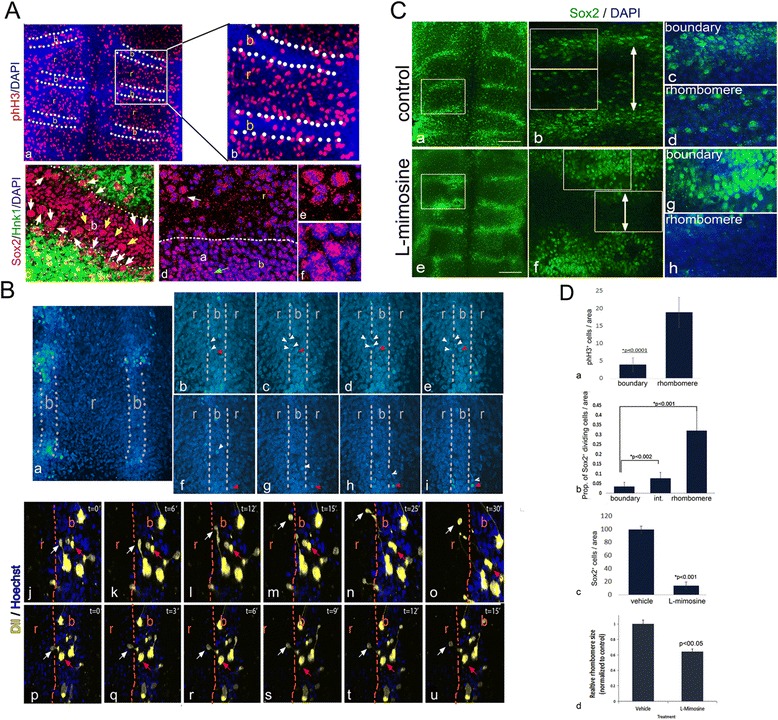Fig. 3.

The proliferation and migration state of Sox2+ cells in hindbrain boundaries. A Representative flat-mount of 18HH hindbrain stained for phH3 and DAPI (a,b). Arrows indicate boundary domains with fewer phH3+ cells. Enlargement of boxed area presented in (b) (n = 10). Flat-mounted view of r4/5 boundary of 18HH hindbrain stained for Sox2, Hnk1 and DAPI (c). White Arrows indicate dividing cells at the lateral edges of the boundary. Yellow arrow indicate mitotic Sox2+ cells at boundary core. Flat-mounted view of r4/5 boundary of 18HH hindbrain stained for Sox2 and DAPI. High magnification of rhombomere area (e), indicated by white arrow in (d), shows Sox2+ dividing cells; high magnification of boundary core (f), indicated by green arrow in (d), shows Sox2 in non-mitotic cells. Dashed line in (b,d) indicates boundary–rhombomere intersection, based on phH3 and Hnk1 staining. B Representative time-lapse microscopy of boundary cells labeled with Hoechst (n = 10) (a–u) and CM-DiI (n = 8) (j–u). Low magnification view showing r4 and its adjacent boundaries (a). Higher magnification views of a boundary and a rhombomere (b–u). White arrowheads/arrows indicate dividing and migrating boundary cells that are contributed to the adjacent rhombomere. Red arrows/arrowheads indicate cells that remain still in the boundary (b–e, j–u) or rhombomere (f–i) throughout the experiment. Dashed line indicates boundary–rhombomere intersection. C Representative flat-mounted hindbrains treated with vehicle (DMEM:F12; a–d) or L-mimosine (e–h) and stained for Sox2 and DAPI (n = 14 in each group). Magnification of boxed areas in (a,e) are shown in (b,f). Magnifications of boundary and rhombomere areas from (b,f) are shown in (c,d,g,h, respectively). D Quantification of phH3+ cells per area in boundary vs. rhombomere (a). Quantification of the proportion of dividing Sox2+ cells in boundary, rhombomere and intersection areas (b). Quantification of Sox2+ cells per area in L-mimosine-treated hindbrains vs. controls (c). Quantification of r3 and r4 sizes in control and L-mimosine-treated hindbrains (d). In all analyses, P values were obtained using the t test. r = rhombomere, b = boundary, Prop = proportion. Scale bars in A,C = 100 μm; in B = 50 μm
